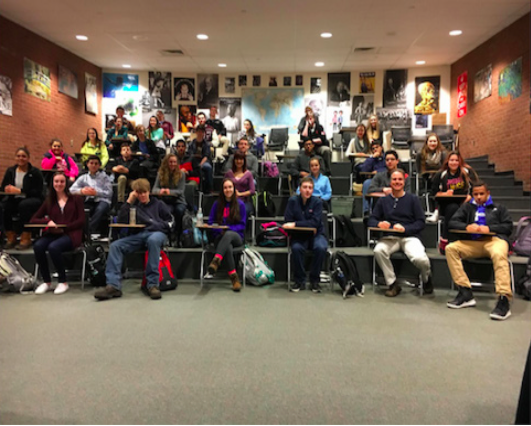Recent modifications established for popular course

Happy about history– Students in AP US History gather for class to collaborate and discuss Colonial America during lecture. Once a week, the students meet in seminar groups to further discuss topics learned.
February 12, 2016
Each year, advanced placement US History (AP USH) sees some of the highest enrollments among juniors of any class. This year, 162 students are enrolled in the class, which represents nearly half of the junior class. In the past two years, though, the course has undergone dramatic changes, both in curriculum and teaching.
The changes were made in part due to the breadth of the course, which continues to span from prehistory close to the present.
The class is being co-taught by social studies teachers Jeff Gawle and Carl Johnson. For the most part, Gawle teaches in the room 701 lecture hall for five periods a day. His class size ranges from 24 to 39 students, more than class sections in typical classrooms. Johnson, on the other hand, teaches small seminars, meeting with about 12 students at a time once a week during student lunch periods.
“He runs a small seminar where we can do document labs, writing labs, analyze certain source materials. In the first semester, we really focused most of the seminar on skill work like writing, reading, and document analysis. In the second half of the year, he’s going to be teaching content more,” Gawle said.
Despite popular depictions of larger class sizes as causing dysfunction, some students actually feel that their learning is enhanced by the broader dialogue made possible by large class sizes.
“I like the bigger classes because it gives more viewpoints towards each topic and it allows a lot of different people to express their opinions,” junior Jake Rappaport said.
Gawle has been teaching AP USH for the past 15 years. Even with the changes that have been instituted, his teaching style has not changed.
“The increase in class size really hasn’t changed the way that I teach. I still use the Socratic method and try to elicit the content from the kids,” Gawle said.
One benefit that Gawle sees in the new format is the uniformity of the lessons being taught. Whereas previously different AP USH teachers moved at their own paces, Gawle can now teach the same material to all students at the same time.
“I think the changes will benefit the students because it gives them a greater opportunity to share their ideas and hear from other students to get a new perspective on historical events and the significance of them,” senior Murdo Smith said.
The class changes came a year after the administration redesigned the AP USH exam last May. The test used to be comprised of 80 multiple choice questions, one Document Based Question (DBQ), and two free response essays. The new exam contains 55 text dependent multiple choice, four short answer questions, one DBQ and one long essay.
Much of the difficulty of the class lays in the breadth and depth of the content in the curriculum relative to other history classes. However, Gawle included that many believe that there is a path to success in the course.
“First, you better love history. You have to be enthusiastic about history. Second, you have to a have a strong work ethic and know how to manage your time well. Lastly, it is important to have strong reading and writing skills,” Gawle said.
Gawle later qualified his “requirements” for success, noting that reading and writing skills could be developed by enthusiastic engagement with historical content. Similarly, many students feel that, despite the recent changes to the course and exam, the formula for success has not truly changed.
“You still have to understand all of the units very well to go into the test prepared,” senior Danielle Hoffman said.

